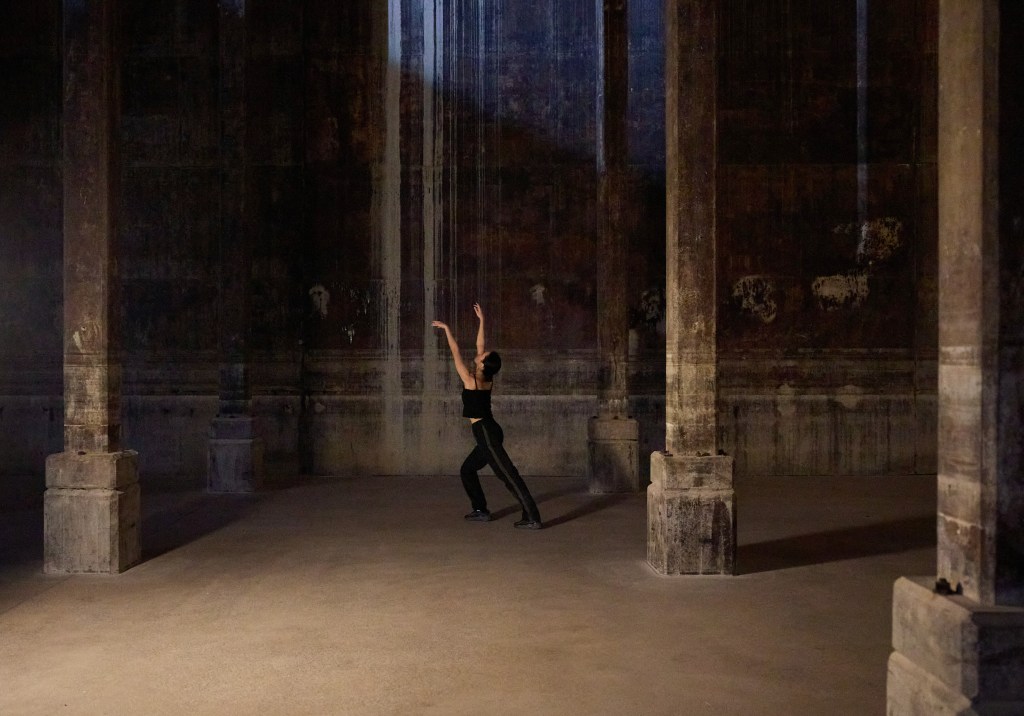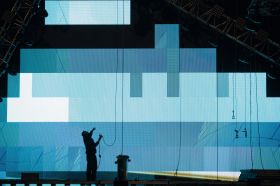Like an industrial swan, Angela Goh was clothed simply in the androgynous uniform of a white tank top and calf-length jersey shorts. We learned that her knee-pads didn’t serve a decorative purpose, but a precautionary one as she dragged her posterior and shins across the floor in slow, measured strokes.
Situated in the Tank of the Art Gallery of New South Wales (AGNSW), this show’s venue of choice was a brutalist cavern. Adding to that sensory deprivation was composer Corin Ileto’s synth-eerie soundscape and lighting designer Govin Ruben’s flickering build-up. The audience had the choice to sit or stand in rows at the perimeter of the Tank, or to observe from the arched stairway above. From up top, Goh’s movements were even more mellifluous as the view of her pivots and dives was unobstructed by the pillars boxing every end.
These self-imposed parameters were harshly delineated, down to the placement of her footwork. A crescent moon was constantly formed through her arms while she weaved backwards through pillars. The gesture was repeated like clockwork while she cast her gaze to somewhere behind our heads. Was it fear? From the shielding blankness of her face, the answers were hard to piece together.
The persona Goh adopted did peek through the repetition in small licks. She took a lighter and held its small flame for the audience to see. The lighting mellowed into a dark pink as the soundtrack descended into harsh drilling. At one point, her voice followed along with the echoes, bouncing off the vastness of the space.
Goh crawled like a robotic dog on her hands and knees, careful not to shatter that illusion of routine as she twisted, squatted and righted herself on her feet before starting over. Yet her body did not make a firm impact with the ground. Like the pillars flanking her, points of contact were as much symbolic as they were tactile impediments. In this way, Goh was as much an excavator as she was a machine or a blade, oiled to move in a manner that served the overground without hastening the natural pace of her body.
There remained gaps in the performance – at some point the narrative of the soundtrack started to become disjointed from the performance, and if this was a style decision, it required firmer definition to narrate the change. At another point the sound of an engine revving overtook the scene, and affixing the same amount of attention on Goh became difficult as she invariably wended her way through the same sequence.
In order to introduce a new element to the work, Goh retreated to the back end of the right furthermost corner of the Tank, to then return to the fore of the performance space. At a specific moment, the view of her body disappearing behind a pillar almost resembled that of a magician’s saw box – providing snapshots of various parts bisecting before they conjoined again. This kind of corporeal extremis executed by Goh was a transference of boundary and dialectic – the rigidity was also smooth, unfeeling and, at times, a little limp. Against that, the dancer’s impetus and commitment to visual dialogue cannot go unmentioned.
Read: Exhibition review: Hoda Afshar – A Curve is a Broken Line, AGNSW
Axe Arch Echo was a suitable choice to reimagine the Tank’s possibilities – a sequence of sound, art and movement in a sunken place. The subterranean performance was a journey through the measures Goh will take to enforce the reality of her body as both a directive force and a responder.
Axe Arch Echo by Angela Goh was performed in the Tank, AGNSW from 7-8 October as part of Volume festival.
This review is published under the Amplify Collective, an initiative supported by The Walkley Foundation and made possible through funding from the Meta Australian News Fund.





